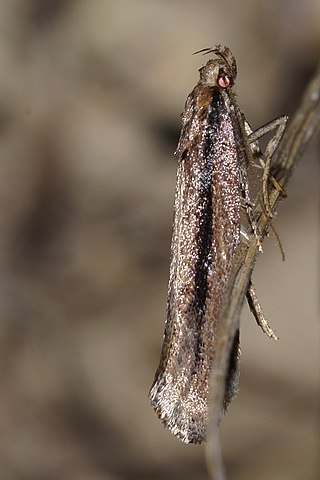Hypatima euplecta is a species of moth in the family Gelechiidae. It was described by Edward Meyrick in 1904. It is found in Australia, where it has been recorded from Queensland, New South Wales, Victoria and South Australia.
Aroga xyloglypta is a moth of the family Gelechiidae first described by Edward Meyrick in 1923. It is found in North America, where it has been recorded from California.
Neotelphusa craterota is a moth of the family Gelechiidae first described by Edward Meyrick in 1913. It is found in South Africa.
Schizovalva rhodochra is a moth of the family Gelechiidae. It was described by Edward Meyrick in 1913. It is found in South Africa.
Commatica lupata is a moth in the family Gelechiidae. It was described by Edward Meyrick in 1914. It is found in Guyana and Peru.
Molopostola calumnias is a moth in the family Gelechiidae. It was described by Edward Meyrick in 1926. It is found in Brazil.
Pityocona xeropis is a moth in the family Gelechiidae. It was described by Edward Meyrick in 1918. It is found in Sri Lanka, southern India, Bengal, northern Vietnam and Java, Indonesia.
Compsolechia tetrortha is a moth of the family Gelechiidae. It was described by Edward Meyrick in 1922. It is found in Peru and Amazonas, Brazil.
Compsolechia volubilis is a moth of the family Gelechiidae. It was described by Edward Meyrick in 1922. It is found in Peru.
Compsolechia salebrosa is a moth in the family Gelechiidae. It was described by Edward Meyrick in 1918. It is found on the Galápagos Islands and in Colombia and Guyana.
Untomia melanobathra is a moth of the family Gelechiidae. It was described by Edward Meyrick in 1918. It is found in Ecuador.
Aristotelia saturnina is a moth of the family Gelechiidae. It was described by Edward Meyrick in 1917. It is found in Peru.
Thiotricha rhodomicta is a moth of the family Gelechiidae. It was described by Edward Meyrick in 1918. It is found in Assam, India.
Aeolanthes dicraea is a moth in the family Depressariidae. It was described by Edward Meyrick in 1908. It is found in India (Assam).
Depressaria prospicua is a moth in the family Depressariidae. It was described by Edward Meyrick in 1914. It is found in South Africa.
Eutorna pabulicola is a moth in the family Depressariidae. It was described by Edward Meyrick in 1906. It is found in Australia, where it has been recorded from Queensland and New South Wales.

Crypsitricha pharotoma is a species of moth in the family Tineidae. It was described by Edward Meyrick in 1888. This species is endemic to New Zealand.

Pammene argyrana is a species of moth belonging to the family Tortricidae.

Epiblema costipunctana is a species of moth belonging to the family Tortricidae. It is native to Europe.

Atomotricha versuta is a moth in the family Oecophoridae first described by Edward Meyrick in 1914. It is endemic to New Zealand and has been observed in both the North and South Islands. The adults of the species are variable in appearance but the three principal variteis are connected b intermediate forms. The female of the species is brachypterous and is incapable of flight. Both the adult male and female have been observed resting on fences during cold winter nights.



